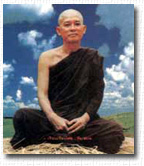Samana Bodhirak
Samana Bodhirak (Mongkhon Rakphong) was born on June 5, 1934 [2433] in the northeastern province of Si Saket. His father passed away when he was very young. Mongkol stayed with his remarried mother who was a successful, wealthy merchant in the town of Ubon Ratchathani, the hometown of his ancestors. Unfortunately, his mother was cheated and fell into poor health, which caused his family to run out of money. Luckily, his uncle, who was a medical doctor, provided support. Mongkon was a hardworking boy and helped his mother as much as possible.
After he finished high school in Bangkok, he continued to study at Pho Chang, an arts school in Bangkok, majoring in fine arts. During this time, he changed his name to “Rak Rakphong.” In 1958, Rakphong started his first career at Thai Television Co., Ltd. He was a producer of children's shows, educational programming, and other academic specials. He also taught art at many schools as a part-time job. He became a relatively famous young person at that time. During this period, his salary amounted to a considerable sum of money: approximately 20,000 baht per month (around $1,000 at that time). At that time, the Prime Minister only made about 12,000 baht per month (around $600). After his mother passed away, Rakphong had to take care of his six siblings until they finished school.
Rak Rakphong was a talented writer. From 1954 - 1955, he wrote a lot of short stories, articles, poems, and songs — and was a paperboy on the side. His most famous song was “Phu Phae [The Loser],” which he composed when he was at Pho Chang school. Moreover, he wrote many movie soundtracks such as “Fa Dam - Phaendin Sung,” “Chun Rak,” “Kratai Pho” for the movie “Thon.”
Rak Rakphong used to be interested in magic and the occult until he came to see the value of Buddhism. He studied the Buddhist path seriously and began to strictly observe its principles. He gave up bad habits and addictions (abayamuk), worldly cares, and passions. He also became a vegetarian and ate only once a day. After gaining confidence in Buddhism, he ordained for the first time as a Thammayut (Dhammayutika) monk on November 7, 1970, at Wat Asokaram, Samutprakan, with Phra Ratchaworakhun was his preceptor. Upon ordination, Rakphong received the ordination name (chaiya) of “Bodhirakkhito” [Caretaker of Bodhi).
Phra Bodhirak continued his strict practice and study of Buddhism. Many lay Buddhists, Thammayut and Mahanikai monks saw the value of his dedication and the peace he had attained. However, Phra Rachaworakhun, Bodhirak’s preceptor, was not keen on Thammayut and Mahanikai monks practicing together because of the differences in orders. Therefore, Phra Bodhirak chose to ordain anew in the Mahanikai order, without leaving the Thammayut order, at Wat Nongkratum, Nakorn Pathom, on April 2, 1971. This time, Phrakhru Sathitawutikhun was his preceptor. Phra Bodhirak was most interested in the essence of the Dhamma and less interested in the particular differences of the two orders (nikai) in the Thai Sangha. He primarily practiced the discipline (thamma-winai), which tended to attract more monks from both orders to follow his “common” way. This development agitated Phra Ratchaworakhun. Phra Bodhirak decided to return his Thammayut registration on the 24th of April. He retained his Mahanikai registration but still had monks from both orders residing with him. Because he did not favor one approach over another, various monks lived together peacefully, focusing on discipline.
Phra Bodhirak and the other monks around him continually studied and practiced a simple lifestyle: for example, eating one (vegetarian) meal a day, not using money, wearing a darker ochre-colored robe, not soliciting contributions, not pouring holy water, not using candles and incense sticks to pay homage, and not using occultism, which is different from most of the Thai Sangha and the Mahatherasamakhom system. Because of this he was often criticized as an “outsider.”
Eventually, the way of Phra Bodhirak encountered several obstacles. He and those around him elected to leave Mahatherasamakhom system at a meeting that took place on the 6th of August, 1975 [2518]. The group called their decision nana sangwat, having the right to live together yet practice differently [note: perhaps in this case the use of the term nana sangwat might best be translated as “different strokes for different folks”]. This group cited code 25 of the constitutional law of Thailand as supporting this freedom and this right.
Phra Bodhirak and his group were reprimanded by the court and were not allowed to call themselves a “Phra” any longer. “Phra” Bodhirak, therefore, became “Samana,” but he still strictly adhered to the practice of the Dhamma.
All of this did not come about intentionally. Bodhirak never sought to divide. These events happened due to practicing the Dhamma, beginning with Rak Rakphong strictly adhering to the Buddhist discipline and then ordaining in both orders. But the practice of Bodhirak and his followers led them to separating from the majority of other monks and a charge in court that continues to affect them today.
Currently, Samana Bodhirak and the Asoke community founded what is called the “Bun-niyom Community,” [trans. note: a play on words; thun-niyom is capitalism; bun is merit; therefore we could translated this as ‘merit-ism’] which lives according to Buddhist principles. They believe in the importance of [the principle found in the Eight-fold Path) “proper view (samma ditthi).” The community adheres to the humanistic values of simple living, self-dependence, creativity, hard work, and perseverance. Not taking advantage of others and being willing to sacrifice has led to a Community of Sufficiency (chumchon khon phopheang).
